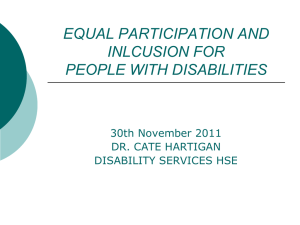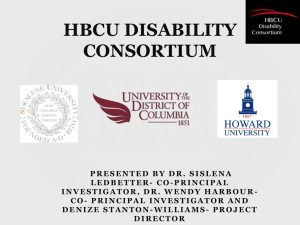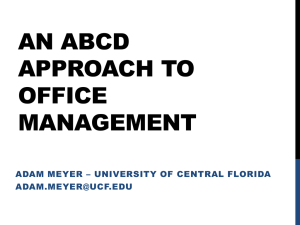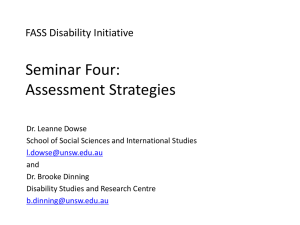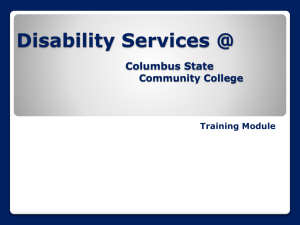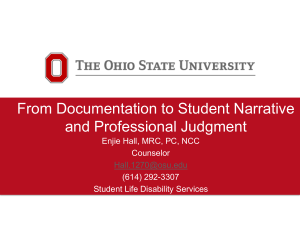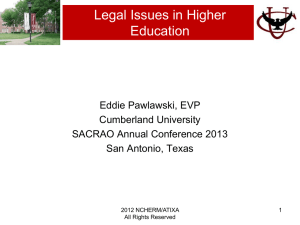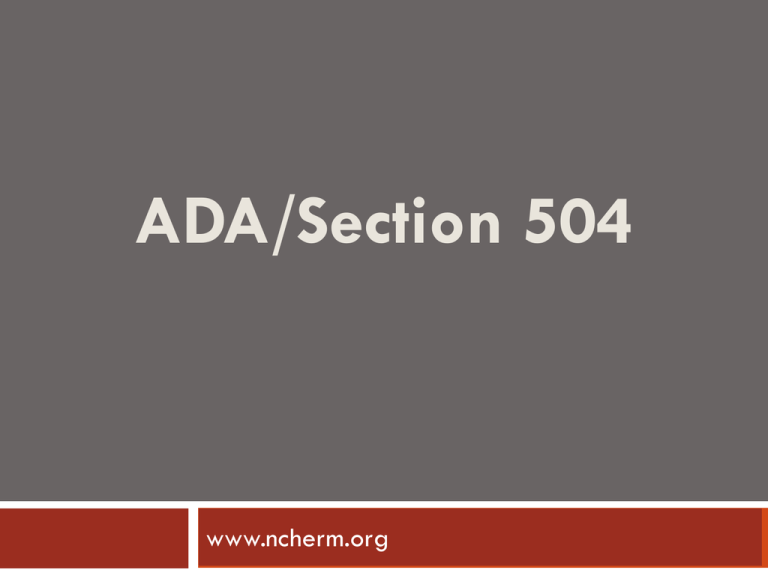
ADA/Section 504
www.ncherm.org
www.ncherm.org
REVIEW OF THE LAW
LEGAL LANDSCAPE
Titles II and III of the Americans with Disabilities
Act of 1990, (“ADA”)
Section 504 of the Rehabilitation Act, 1973
Fair Housing Act (“ FHA”)
State Law
Title II & III ADA
1990
4
Title II
Prohibits discrimination on the basis of disability by public entities,
including state colleges and universities, regardless of whether they
receive Federal financial assistance
Title III
Prohibits discrimination on the basis of disability in private
education facilities and in the activities of places of public
accommodation (businesses that are generally open to the public
and that fall into one of 12 categories listed in the ADA)
The language of ADA tracks Section 504 and explains that the
remedies, procedures and rights under the ADA are the same as
under the Rehabilitation Act
© 2012 ATIXA all rights reserved
Section 504 of the Rehabilitation
Act, 1973
5
A federal civil rights law, prohibits discrimination on
the basis of disability in all programs or activities that
receive Federal financial assistance
Forbids institutions from excluding or denying
individuals with disabilities an equal opportunity to
receive program benefits and services
Codified at 29 U.S.C. § 701
Enforced by the U.S. Dept. of Education
Covers “any program or activity”
© 2012 ATIXA all rights reserved
Section 504
Scope of Covered Programs
6
All of the college’s operations, programs and
activities subject to Section 504 requirements,
including:
Academics
Athletics
Employment
Housing
Events
Web-based educational services
© 2012 ATIXA all rights reserved
Section 504
Administrative Requirements
7
Schools must have clearly defined policies and procedures and
implement them consistently
Schools must have preventive measures in place to position an
institution to manage a report of disability based discrimination.
Schools must provide:
notice of nondiscrimination
notice of 504/ADA Coordinator
notice of 504/ADA grievance procedures
notice of how to obtain academic adjustments and auxiliary
aids
© 2012 ATIXA all rights reserved
Fair Housing Act
FHA makes it unlawful to “discriminate against any
person in the terms, conditions, or privileges of sale
or rental of a dwelling, or in the provision of
services or facilities in connection with such a
dwelling because of a handicap person …”
FHA applies to residential “dwellings”, a term that
likely encompasses campus housing including
residence halls and dormitories.
WHY IS IT IMPORTANT TO
UNDERSTAND DIFFERENT LAWS?
Laws apply differently to public vs. private
institutions
Laws apply different definitions and standards
as it relates to service vs. assistance/comfort
animals
Laws may impose different standards or
response protocols
Who Is Protected Under Sec 504?
10
Under this law, individuals with disabilities are
defined as
persons
with a physical or mental impairment which
substantially limits one or more major life activities
persons who have a history of having a physical or
mental impairment, or
persons who are regarded as having a physical or
mental impairment that substantially limits one or
more major life activities
© 2012 ATIXA all rights reserved
What Is A “Major Life Activity”?
11
Major life activities include:
Caring for one's self
Walking
Seeing
Hearing
Speaking
Breathing
Working
Performing manual tasks
Learning
© 2012 ATIXA all rights reserved
What Is A “Major Life Activity”?
(cont’d)
12
Examples of impairments which may substantially limit
major life activities, even with the help of medication
or aids/devices, are: AIDS, alcoholism, blindness or
visual impairment, cancer, deafness or hearing
impairment, diabetes, drug addiction, heart disease,
and mental illness, learning disability.
© 2012 ATIXA all rights reserved
What Is A “Major Life Activity”?
(cont’d)
13
For students this means that a student with a
qualifying disability will be “otherwise qualified”
for admission to a specific academic program if
he/she can meet all the necessary and articulated
“essential functions” of the college program with
reasonable accommodations
A student with a disability is also protected from
discriminatory harassment directed at them because
of their disability
© 2012 ATIXA all rights reserved
14
Accommodation
504/Title II Principles
Colleges must ensure that students with disabilities are not
discriminated against due to the absence of auxiliary aids or
services. (Examples: taped texts, note takers, readers, adapted
equipment)
Colleges must make academic adjustments or other reasonable
modifications to policies, practices, or procedures to ensure they do
not discriminate. (Examples: change in length of time to complete a
program, substitution of courses).
Test format and administration should measure a student’s
achievement, not the student’s impaired sensory, manual, or speaking
skills (except where such skills are the factors the test purports to
measure).
© 2012 ATIXA all rights reserved
Accommodations Process
15
Colleges and students should engage in an “interactive
process” to determine appropriate accommodations that
meet the student’s individual needs.
If a student wants an academic adjustment, he or she has
the initial obligation to provide notice to the institution of
a qualifying disability and need for academic adjustment
or auxiliary aid or services.
Colleges may establish reasonable standards for
documentation.
Aids and adjustments must be provided in a timely
manner.
© 2012 ATIXA all rights reserved
Considerations for Providing
“Equality” in Opportunities
16
1.
2.
What can the institution do to provide students with
disabilities equal access to the educational benefits or
opportunities provided through technology?
How do the educational opportunities and benefits
provided to students with disabilities compare to those
provided to students without disabilities?
Are they equally available?
Are they available in a timely manner, similar to those provided
to students without disabilities?
Will it be more difficult for students with disabilities to obtain
the educational opportunities than for non-disabled students?
© 2012 ATIXA all rights reserved
17
ADDRESSING SIGNIFICANT
ISSUES
© 2012 ATIXA all rights reserved
504/ADA Guidelines Regarding
Mental Illness
18
A student with a mental disorder has a disability
Both the ADA and Section 504 Apply
Section 504 gives recourse to students who are discriminated
against on the basis of a recognized disability.
The Americans with Disabilities Act (ADA) entitles students
who are otherwise qualified to participate in the programs and
activities of college to reasonable accommodations once they
seek qualification with the campus disability services office.
Neither law requires that a suicidal student march into the
disability services office to qualify as disabled.
Today there are only limited circumstances in which OCR will
find that our decision to separate a student for disruptive
behavior is not a violation of Section 504.
© 2012 ATIXA all rights reserved
A Psychiatric Disability Is….
19
Defined as a mental impairment that substantially
limits one or more major life activities
Examples of mental disabilities include:
Major depression
Bipolar disorder
Schizophrenia
Anxiety disorders
Post-traumatic stress disorders
© 2012 ATIXA all rights reserved
Addressing Involuntary
Withdrawal
20
Engaging in withdrawing a student with a disability
is complex
law changed in 2011 – no longer applies to “harm
to self” as a basis for involuntary withdrawal.
However, if a student is suicidal, no documentation is
needed to assume a disability
Students with disabilities have specific rights set forth
by law
The institution must engage in the “Direct Threat Test”
The
© 2012 ATIXA all rights reserved
“Direct Threat” Test
21
Student poses a “Direct Threat”, a “significant risk” of
substantial harm or safety of the individual to others that
cannot be eliminated or reduced by reasonable
accommodation.
To rise to the level of a direct threat, there must be a high
probability of substantial harm and not just a slightly
increased, speculative, or remote risk;
Significant risk determination must be made by considering (1)
the duration of the risk, (2) the nature and severity of risk, (3)
the likelihood that the potential harm will occur, and (4) the
proximity of the potential harm.
OCR- DUE PROCESS is necessary to challenge factual
assumptions to challenge that behavior is a “direct threat.”
© 2012 ATIXA all rights reserved
“Direct Threat” Test
22
In a direct threat situation, a college needs to make an
individualized and objective assessment of the student's
ability to safely participate in the college's program;
This assessment must based on a reasonable medical
judgment relying on the most current medical knowledge
or the best available objective (non-medical) evidence;
The assessment must determine; the nature, duration,
and severity of the risk; the probability that the
potentially threatening injury will actually occur; and
whether reasonable modifications of policies, practices,
or procedures will sufficiently mitigate the risk.
© 2012 ATIXA all rights reserved
Assessment for Direct Threat Test
23
Not mandated to be a therapeutic assessment,
but an overall assessment of a student’s ability to
function effectively and safely in a campus
environment.
We are to use objective evidence, and if possible,
the most current medical knowledge available
OCR is, by practice, deferential to our
determination of direct threat, but they insist that
we make one.
© 2012 ATIXA all rights reserved
Ideation, Non-specific Threats,
Gestures
24
The Direct Threat Test tells us that a student
who is ideating, threatening or who is making
non-specific gestures without a plan or means
to carry though may not represent a high
probably of substantial harm.
For example, in the next case, George Washington
University separated a student who reported
suicidal thoughts at a hospital, it clearly
overreacted. It did not make a finding that met the
four elements of the direct threat test.
© 2012 ATIXA all rights reserved
Nott v. George Washington
University
25
Student, Jordan Nott sought treatment for depression and suicidal
ideation following the suicide of a friend
The information was shared with administration at George Washington
Mr. Nott was removed from campus on an interim basis as a substantial
and immediate harm to himself or others
The University offered Mr. Nott a hearing on the interim suspension or
the right to voluntarily withdraw and take a leave of absence
Following completion of recommended treatment and clearance by the
counseling center he would be allowed to return
Nott sued, alleging his rights were violated under ADA, Sec. 504,
violation of privacy, infliction of emotional distress and other state and
federal laws.
© 2012 ATIXA all rights reserved
Scheiszler v. Ferrum College
26
When the Dean discovered that a student was
suicidal, student was made to sign a behavioral
contract. Further indications were given to the Dean
that student still intended to try to kill himself. Student
did in fact commit suicide.
A negligence lawsuit claimed Ferrum knew or should
have known that student was likely to attempt to hurt
himself if not properly supervised, and that because
Ferrum negligently failed to take adequate
precautions, student died as a result
© 2012 ATIXA all rights reserved
27
The Court said that Ferrum College had a duty to protect
a student from the foreseeable danger that he would
commit suicide. While there is generally no duty to assist
or protect someone from harming themselves, an
affirmative duty will arise when there is a “special
relationship.” The court found a “special relationship”
was formed by Ferrum’s undertaking of efforts to
intervene in the suicidal behavior. Where there was an
obvious and “imminent probability of harm”, the college
had a duty to do more than it did. Ferrum did not
follow-up on subsequent suicide threats made by student
© 2012 ATIXA all rights reserved
SERVICE vs. COMFORT
ANIMAL
ADA Title II and III, Section 504 and FHA all
prohibit discrimination based on disability and they
all impose various obligations upon colleges and
universities to accommodate service or assistance
animals.
ADA: SERVICE ANIMAL
DOJ explicit that the following animals are not
considered service animals under Title II or Title III:
- Any animal besides a dog or miniature horse
- Animals that serve solely to provide crime
deterrent effect, and
- Emotional support, comfort or companionship
animals
SECTION 504: SERVICE ANIMAL
Section 504 implementing regulations do not
define “service animal”, Department of
Education Office of Civil Rights (“OCR”) adopted
definition provided by Title II and III of the ADA.
FAIR HOUSING ACT
SERVICE/ASSISTANCE ANIMAL
HUD applies a broader definition of “assistance
animal” when enforcing Section 504 reasonable
accommodation purposes, in the housing context
HUD broadens “service/assistance animal” to
include emotional support animals that provide very
private functions for persons with mental or
emotional disabilities.
STATE LAW
Many states adopted antidiscrimination statutes
that require accommodation of service animals.
Therefore, institutions should consult local laws
when setting campus policies related to service
animals
RELEVANT CASE LAW
Secretary, U.S. Dept. of Housing and Urban Dev.
vs. University of Nebraska at Kearney
Charge of discrimination filed because the University
refused to allow a student to keep a dog in her
university-owned apartment to support her with
depression and anxiety. Additionally, University also
alleged to “illegally inquire into the nature and severity
of the student’s disability.
PRACTICE POINTERS
Federal laws provide a floor, not a ceiling
Consider how, or whether, to distinguish between the
treatment of trained “service animals” and
potentially untrained “assistance animals” on
campus
Remember accommodations are not limitless
Adequately train disability services and residential
hall staff on nuances in law
SERVICE AND ASSISTANCE ANIMAL
POLICY SUGGESTIONS
Overarching Principle: identify commitment to compliance with state
and federal laws and what office to contact for accommodation of
disabilities
Request for Service or Assistance: University will determine on
case-by-case basis whether such animal is a reasonable
accommodation…balance needs of individual with impact of
animals on campus as a whole.
Request for Documentation: University may require sufficient
information and documentation to determine reasonable
accommodation…letterhead of treating physician and includes
information that allows university to determine qualified disability,
how animal assists, animal training, and nexus with disability and
animal services.
SERVICE AND ASSISTANCE ANIMAL
POLICY SUGGESTIONS
Clear articulated accommodation review process
Requirements for notification to institution on request
for service animals i.e. 30 days before move-in
date.
Clear articulated reasons for removal of service
animal.
Owner fully responsible for animal vaccination,
licensure, animal health, leash control, etc.
Appeal/ Grievance Process
APPLICATION TO YOUR
INSTITUTIONAL POLICIES
AND PROGRAMS
Implications for Responsibility
38
Since all school programs, benefits and activities are
subject to Sec. 504 and ADA, All faculty and staff
are responsible to comply with the requirements
This includes all professional interactions with students
by faculty or staff
For
example, if a faculty member denies a student who
is blind an equal opportunity to participate in a course
by assigning inaccessible course content, the school can
be held legally responsible
© 2012 ATIXA all rights reserved
Critical Areas to Audit
39
Disability Services Office protocol
The
Title IX Coordinator is not the head of this office!
On-line admissions and/or registration process
Check all instructional program standards, and if
“essential functions” are identified if important
Recognize that accommodations must go beyond
merely serving blind individuals
Grievance protocol for reporting and addressing
disability related complaints
© 2012 ATIXA all rights reserved
More About Program Standards
40
Creation of well-articulated program standards are
essential to address circumstances when student with a
disability cannot complete a program or benefit from it
Identify
graduation competencies
Ensure any licensure/certification requirements are
identified and programs appropriately aligned
Ensure program requirements are consistent with
accreditation requirements
Ensure all field requirements are identified (both in clinical
assignments and in the profession)
© 2012 ATIXA all rights reserved
Program Standards (cont)
41
Look
at each course to determine what the outcomes are
and how students with disabilities may be able to
accomplish these with accommodations
Ensure any use of web-content or e-readers are fully
functional to accommodate spectrum of disabilities
Consider applying Universal Design: Universal
Design for Learning (UDL) is an educational
framework, based on research, that guides the
development of flexible learning environments that
can accommodate individual learning differences
© 2012 ATIXA all rights reserved
Program Design
42
The regs state that whether a school is a bricks and
mortar institution, on-line or offered in another
virtual context the institution must comply with
Federal disability discrimination laws
The
compliance standards must be in place even if
there are no currently enrolled students with visual
impairments
Schools must include accessibility requirements and
analysis as a part of their acquisition procedures.
Important questions to ask include
© 2012 ATIXA all rights reserved
Title IX Coordinator
Compliance Considerations
43
Sec. 504 and the ADA require that higher education
institutions designate at least one person to coordinate
compliance efforts
Every institution of h.e. must adopt and publish
grievance procedures to resolve complaints of
noncompliance
The D.O.E. recommends that all faculty and staff
participate in professional development training about
accessibility and emerging technology and their role in
institutional compliance with disability discrimination law
© 2012 ATIXA all rights reserved
44
Section 504/ADA Coordinator and
Grievance Procedures
Must provide oversight of disability program
compliance
Must ensure dissemination of notice of the
institution’s non-discrimination policy
Must ensure civil-rights based grievance
procedures are in place to address complaints of
discrimination
© 2012 ATIXA all rights reserved
45
Thank you!
ADA QUESTIONS?
Saundra@NCHERM.org
© 2012 ATIXA all rights reserved


